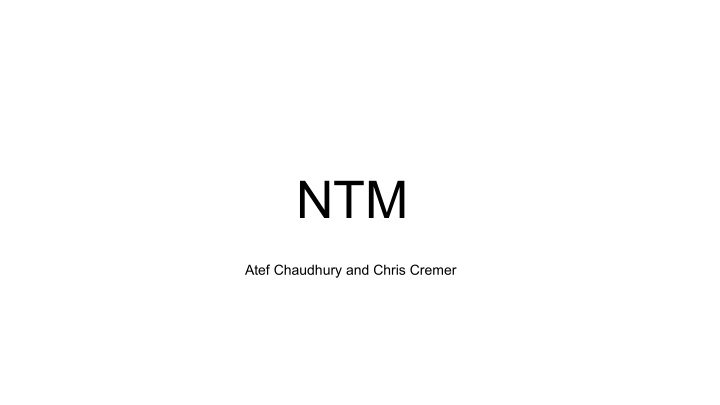



NTM Atef Chaudhury and Chris Cremer
Motivation
Memory is good Working memory is key to many tasks - Humans use it everyday - Essential to computers (core to Von Neumann architecture/Turing Machine) Why not incorporate it into NNs which would let us do cool things
What about RNNs? Shown to be Turing-Complete Practically not always the case hence there are ways to improve - (e.g. attention for translation) https://distill.pub/2016/augmented-rnns/
Core idea Similar to attention, external memory could help for some tasks - e.g. copy sequences with lengths longer than seen at training One module does not have to both store data and learn logic (the architecture introduces a bias towards separation of tasks) - hope is that one module learns generic logic while other tracks values
Architecture
Overview https://distill.pub/2016/augmented-rnns/
Soft-attention reading https://distill.pub/2016/augmented-rnns/
Soft-attention writing https://distill.pub/2016/augmented-rnns/
Addressing Content-based - (cosine similarity + softmax between key vector and memory) Location based - Interpolation with last weight vector + shift operation
Results
Copying Feed an input sequence of binary vectors, and then expected result is same sequence (output after the entire sequence has been fed in)
NTM LSTM
What’s going on?
Other tasks Repeated copy (for-loop), Adjacent elements in sequence (associative memory), Dynamic N-grams (counting), Sorting Memory accesses work as you would expect indicating that algorithms are being learned Generalizes to longer sequences when the LSTM on its own does not - All with less parameters as well
Final notes Influenced several models: Neural Stacks/Queues, MemNets, MANNs Extensions - Neural GPU to reduce sequential memory access - DNC for more efficient memory usage
Discrete Read/Write Sample distribution over memory addresses instead of weighted sum Why? - Constant time addressing - Sharp retrieval Papers: RL-NTM (2015), Dynamic-NTM (2016)
Unifying Discrete Models
Unifying Discrete Models
RL-NTM Variance Reduction
RL-NTM - Variance Reduction
RL-NTM - Variance Reduction where
RL-NTM - Variance Reduction
RL-NTM - Direct Access - All the tasks considered involved rearranging the input symbols in some way - For example: reverse a sequence, copy a sequence - Controller benefits from a built-in mechanism that can directly copy an input to memory or to the output - Drawback: domain specific
Difficulty Curriculum RL–NTM unable to solve tasks when trained on difficult problem instances - Complexity of problem instance measured by the maximal length of the desired output To succeed, it required a curriculum of tasks of increasing complexity - During training, maintain a distribution over the task complexity - Shift the distribution over the task complexities whenever the performance of the RL–NTM exceeds a threshold
RL-NTM - Results
Dynamic-NTM
Dynamic-NTM Transition from soft/continuous to hard/discrete addressing - For each minibatch, the controller stochastically decides to choose either to use the discrete or continuous weights - Have hyperparameter determine the probability of discrete vs continuous - Hyperparameter is annealed during training
D-NTM Variance Reduction where b is the running average and σ is the standard deviation of R
D-NTM - Results bAbI Question answering - reads a sequence of factual sentences followed by a question, all of which are given as natural language sentences. LSTM controller FF controller
Learning Curves The discrete attention D-NTM converges faster than the continuous-attention model - Difficulty of learning continuous-attention is due to the fact that learning to write with soft addressing can be challenging.
TARDIS (2017) Wormhole-Connections help with vanishing gradient Uses Gumbel-Softmax Improved results
Takeaways Learning memory-augmented models with discrete addressing is challenging Especially writing to memory Improved variance reduction techniques are required
Thanks
Recommend
More recommend